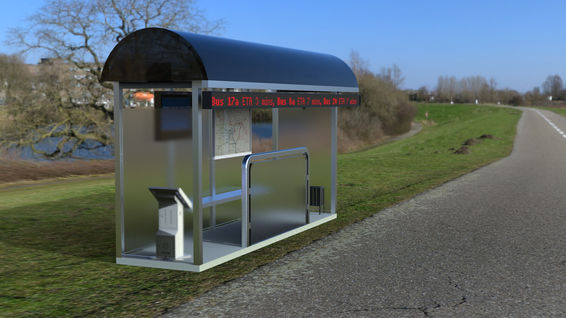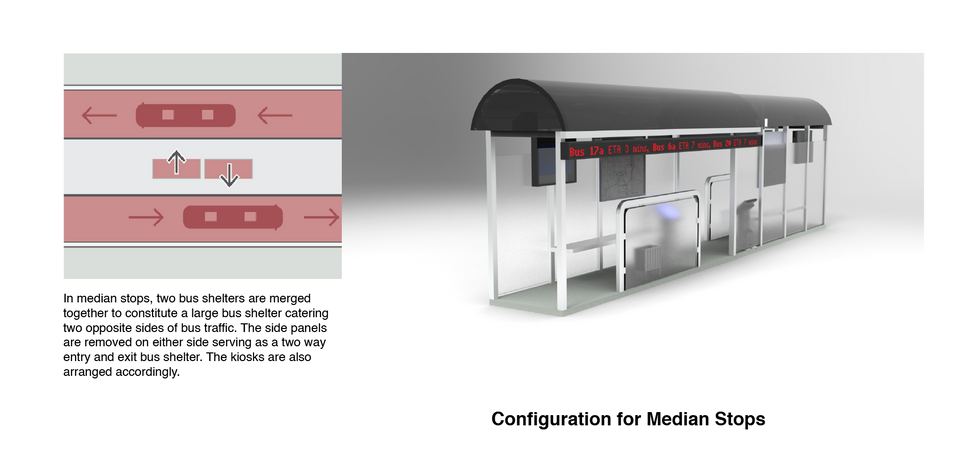TransitAid
A Smarter Bus Shelter
Class Project 2021
3 weeks

The design challenge
Students in your locality use the bus system are dissatisfied with the bus stops along the route of the bus they take from their apartments to the main campus location. Some stops offer no weather protection, while others offer no relevant information on scheduling, events or other necessities.
Problem Statement
“Design the perfect bus stop for yourself and your colleagues. Consider all your needs while waiting at or while departing from the bus stop. Your prototype should be a quarter scale in size.”
Research
User Bio

Oliver
Rochester Institute of Technology
27 Years Old
Pursuing Ph.D. at Center of Imaging Sciences
Biography
Oliver is a 27-year-old Ph.D. student at the Chester F. Carlson Center for Imaging Science at RIT. Oliver stays in an apartment along with his roommates in a quieter suburban Rochester
The RIT campus is about 5 miles away from his apartment and Oliver relies on the RIT Off-Campus Shuttle and the RTS Bus service to get to campus. He plans of moving to a nearby apartment due to extremely cold winters and to reduce travel times to campus.
Oliver is a very punctual person when it comes to reaching his lab for research work. He gives top priority for his ongoing research and doesn’t like to waste time.
Pain Points



Most of the stops in the bus route do not have a shelter apart from a small platform to wait. This is true for most of the suburban stops along the route
Rochester is one of the snowiest cities in the state of New York. Situated right south of Lake Ontario, it is prone to strong chilly gusts from the north. Temperatures vary from -7-degree Celsius to -20-degree Celsius during winters
Sometimes, the Regional Transport Bus of Rochester service gets delayed at certain time periods and tracking buses at certain routes in real time becomes a hassle
Technology Research
Provision of an all-weather-proof bus shelter. At least, in those bus stops where there is no provision of a shelter
Bus shelter should have provisions for heavy snowfall with a proper entry and exit points along with a wheelchair accessible entry
Provision for a kiosk, information displays and Automatic Vehicle Location services would be a great addition
Provision for heating during winters
Focus Areas

Halogen heating and lighting systems can be a solution to solve the issue of discomfort due to cold weather

Polycarbonate or laminated glass roofing can help bringing in natural light to the bus shelter
Bus stop capacity is often an important consideration in the planning of bus stops serving multiple routes within urban centers. Limited capacity may mean buses queue up behind each other at the bus stop, which can cause traffic blockages or delays. Bus stop capacity is typically measured in terms of buses/hour that can reliably use the bus stop. The main factors that affect bus stop capacity are:
-
Number of loading areas (or number of buses that can stop at one time)
-
Average dwell time (How much time it takes a bus to load/unload passengers)
-
G/C ratio of nearby traffic signal (green time / cycle length)
-
Clearance time (time it takes bus to re-enter the traffic stream)

A Cost Distribution Estimate
Bus Stop Types
Transit stop configurations are based on the type of traffic they handle, their location in the city, type of vehicles they cater to, rider frequency and the type of riders they cater.
Each of these must be studied in relationship to the local context and can be used with a variety of vehicle types.
Ideation




Modelling
I made mockups of a few bus stop shelters using foam core to a quarter scale to get an idea and visualize how those shelters might look like in real life.

Final CAD Render
Modelled in Fusion 360
Rendered in KeyShot


Modular Configurations
The Bus shelter can be configured to different modules based on space available in different situations.


















